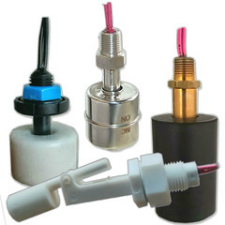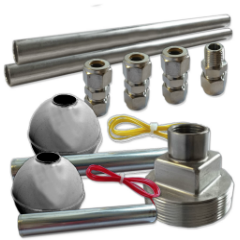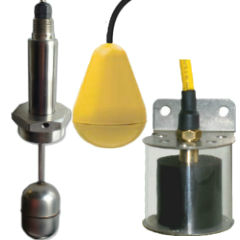Standard Single Level Float Switch
We offer a wide variety of vertical and horizontal liquid level float switches, available in all stainless steel, stainless steel and buna, or plastics such as PVC, polypropylene, or PTFE. These versatile switches can be used in conjunction with high and low level alarms or control switching. There are many different threaded mounting options, reed switch choices including single pole single throw and single pole double throw, customizable lead wire lengths. These economical single point floats are a great choice for OEM’s and are often in stock and quick to ship.
Field Assembled
Field assembled float switches are a great choice if you need to customize a sensor in the field or you need it fast and cannot wait for a custom made to order float switch. The complete kit comes with everything needed for a two level sensor, if you require more than two levels additional fittings and switch points can be purchased separately. These versatile float switches are available in brass & buna or stainless steel and are a good choice for many different applications.

Custom Multi Level Float Switch
We specialize in custom made to order multi-level float switches, let us know your specific application and we will make a float sensor to your specifications. These sensors are ideal for monitoring multiple switch points, controlling pumps & valves, warning of high or low level alarms, and indicating tank levels. With the ability to be made from various materials with a vast choice of threading mounting options, our engineers will work closely with you to create the exact liquid level float switch for your application needs.
Speciality Level Sensors
We offer a variety liquid level sensors including low water conductive and sump pump style float switches. Our specialty floats are made for difficult or demanding applications such as high temperatures, thick or sticky liquids, high turbulence, or difficult mounting. These sensors can be customized and are available in a variety of materials. When a traditional float type level switch doesn’t meet your needs, a specialty float may be exactly what you are looking for.
FAQ
What does a float switch do?
A liquid level sensor, like a float switch, is used to detect or measure the level of liquid inside a container or tank. A float switch can be used to control the operation of a pump or valve to maintain a specific level of liquid in a tank. A float switch can also be used as an indicator, an alarm, or to send signals that will alert a person or building management control system as to what the liquid level is or how it affects the control of other devices.
Float switches play a vital role in monitoring and controlling liquid levels in various applications, from residential sump pumps to complex industrial processes. By employing a simple yet reliable mechanism, float switches contribute to safety, efficiency, and environmental protection across diverse industries. Whether it’s safeguarding against flooding or optimizing industrial processes, these unassuming devices continue to demonstrate their indispensability in countless applications worldwide.
How does a float switch work in a water tank?
A float switch is utilized to monitor the liquid level within a tank. The float, which contains a magnet, moves freely on a shaft as the water level rises and falls. A reed switch which is enclosed within the shaft, connected to a pair of wire leads, has a set of contacts that are open. When the water level moves it causes the float to pass by the reed switch and the magnet closes its contacts to provide a signal that the desired water level has been reached. When the float moves away from the reed switch the contacts open signaling that the float is no longer at the specified level.
Can a float switch go bad?
A float switch, while generally very reliable, can fail or go bad due to incorrect material choices, physical damage, or improper use. Physical damage to the float and/or shaft could impede the floats movement and prevent the float switch from functioning correctly, as it may not reach the desired position to trigger the reed switch. Accumulation of debris, sediment, or other contaminants in the tank can also interfere with the movement of the float. Choosing the wrong material can lead to corrosion of the float switch which could cause malfunctions in the switch mechanism, hindering its ability to operate properly. Hooking up the float switch up to power sources that exceed the switch ratings can also cause the switch to fail.




